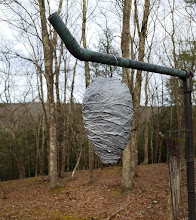
VUE Map: Concept mapping (sometimes referred to as ‘mind-mapping’) as a learning tool has been documented in 40+ years of cognitive science research. The Visual Understanding Environment (VUE) is a concept and content mapping application, developed by Tufts University to support teaching, learning and research. Simple tools and a basic visual grammar consisting of nodes and links, maps and/or organizes relationships between concepts, contexts, ideas and digital content in non-linear ways.
Rhizome is a philosophical concept developed by Gilles Deleuze and Félix Guattari in their Capitalism and Schizophrenia (1972-1980) project. Based on the botanical rhizome, it is what Deleuze calls an "image of thought" that apprehends multiplicities. Rhizome describes theory and research that allows for multiple, non-hierarchical entry and exit points in data representation and interpretation.
Carl Jung used the term rhizome to describe the universal unconscious, the presence in all people of a set of shared images and their significance. The Internet and its rapidly spreading communities is described as a rhizome. It is also gaining rapid momentum in pedagogy, particularly when utilizing Internet and computer-based technologies.
Rhizomes oppose the idea that knowledge must grow in a tree structure (arborescent) from previously accepted ideas. New thinking need not follow established patterns, new conceptual territories result from unpredictable juxtapositions. The root of the rhizomic plant needs to be close to the surface to flower, as does rhizomatic thinking need to be present in daily life to affect thought. It is an open system, most effective as a tool when personally incorporated, accessing the concept of rhizome through experience.
With this motivation, I cast the rhizome as a site of defiance to the arborescence of packet documentation, progress “report” narrative and—thinking forward—to the structure of the Final Portfolio. I believe my process, practice and acquiring knowledge has always dodged linear interpretation. My challenge was to think more originally, through thinking more organically.
How to articulate the complexities of art and art-making, subjects that are conceptually and methodologically both personal and global. Off-shoots ricochet in all directions; classification seems impossible; the task of selecting and following interactions, terms and relations are massive. How to think this?
As artists, we are faced by a need to find alternative ways to analytically respond. Artists recognize the skills necessary in the process: acute observational skills, intermingling experience with theory and practice, 'fieldwork' of an experience, and coming to new realizations, often in manner difficult to detect. To capture the ways in which I understand and see certain associations unfolding in my field of study, I responded to the concept of rhizome as a new way of 'thinking' these connections.
By the end of the semester, I began creating a Visual Understanding Environment (VUE) map as an act of bridging gaps between the conceptual, methodological and experiential. I downloaded the free and open-source software and learned the capabilities of the current version of the program. 'Fieldnotes' of a kind were kept by a semester-long journaling experiment, and it is through reflection on these, the map resulted.
Describing how connections and 'rhizomatic' thought appear in the everyday is a difficult task. The VUE map has a larger purpose than creating a system of interlinked concepts. It has to show what that system does; so I will be continuing forward with this project into G4, along with developing a pedagogy with a rhizomatic perspective.

No comments:
Post a Comment